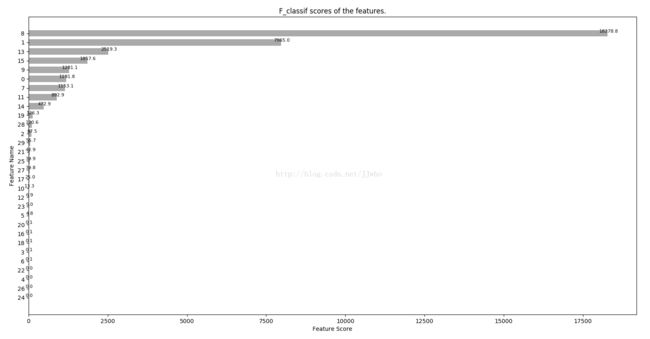特征选择与评分的可视化显示 - 在Python中使用Matplotlib绘制“横着的”条形图
特征选择的一种常用方法是计算各个特征与标签的相关性,给特征打分,根据分值大小排序进行选择。例如:scikit-learn中的SelectKBest和SelectPercentile默认的"f_classif"就是通过方差分析给特征打分。我们常常会直接使用 SelectKBest 进行特征选择,但有的时候,我们希望了解各类特征的价值,从而指导我们可以进一步致力于挖掘数据哪方面的特征。这时候将特征的评分可视化一下看起来就会非常方便。
这里以鸢尾花数据集为例,使用“横着的”条形图进行特征可视化(当然竖着的也行哈)

这里以鸢尾花数据集为例,使用“横着的”条形图进行特征可视化(当然竖着的也行哈)
一、简单的可视化函数:
import numpy as np
from sklearn.feature_selection import SelectKBest
from matplotlib import pyplot as plt
def plot_feature_scores(x, y, names=None):
if not names:
names = range(len(x[0]))
# 1. 使用 sklearn.feature_selection.SelectKBest 给特征打分
slct = SelectKBest(k="all")
slct.fit(x, y)
scores = slct.scores_
# 2. 将特征按分数 从大到小 排序
named_scores = zip(names, scores)
sorted_named_scores = sorted(named_scores, key=lambda z: z[1], reverse=True)
sorted_scores = [each[1] for each in sorted_named_scores]
sorted_names = [each[0] for each in sorted_named_scores]
y_pos = np.arange(len(names)) # 从上而下的绘图顺序
# 3. 绘图
fig, ax = plt.subplots()
ax.barh(y_pos, sorted_scores, height=0.7, align='center', color='#AAAAAA', tick_label=sorted_names)
# ax.set_yticklabels(sorted_names) # 也可以在这里设置 条条 的标签~
ax.set_yticks(y_pos)
ax.set_xlabel('Feature Score')
ax.set_ylabel('Feature Name')
ax.invert_yaxis()
ax.set_title('F_classif scores of the features.')
# 4. 添加每个 条条 的数字标签
for score, pos in zip(sorted_scores, y_pos):
ax.text(score + 20, pos, '%.1f' % score, ha='center', va='bottom', fontsize=8)
plt.show()该函数的输入是 特征向量list、标签list 和 特征名称list,不输入特征名称时默认按特征向量的下标显示。
二、载入鸢尾花数据集,并手动输入特征名称
from sklearn import datasets
def load_named_x_y_data():
""" 载入数据,同时也返回特征的名称,以便可视化显示(以鸢尾花数据集为例) """
# x_names = ["花萼长度", "花萼宽度", "花瓣长度", "花瓣宽度"]
x_names = ["sepal_lenth", "sepal_width", "petal_lenth", "petal_width"]
iris = datasets.load_iris()
x = iris.data
y = iris.target
return x, y, x_names
def main():
x, y, names = load_named_x_y_data()
plot_feature_scores(x, y, names)
return
if __name__ == "__main__":
main()
计算结果显示“花瓣长度”特征最为重要,“花瓣宽度”特征也很重要。而花萼的两个特征重要性却相当低。
我们可以简单看一下该数据集包含的三类鸢尾花都长啥样~
1.山鸢尾(setosa)
2.杂色鸢尾(Versicolour)
3.维吉尼亚鸢尾(Virginica)
好像也看不出来什么~~23333~
四、最后附上完整代码:
# coding:utf-8
from sklearn import datasets
import numpy as np
from sklearn.feature_selection import SelectKBest
from matplotlib import pyplot as plt
def load_named_x_y_data():
""" 载入数据,同时也返回特征的名称,以便可视化显示(以鸢尾花数据集为例) """
# x_names = ["花萼长度", "花萼宽度", "花瓣长度", "花瓣宽度"]
x_names = ["sepal_lenth", "sepal_width", "petal_lenth", "petal_width"]
iris = datasets.load_iris()
x = iris.data
y = iris.target
return x, y, x_names
def plot_feature_scores(x, y, names=None):
if not names:
names = range(len(x[0]))
# 1. 使用 sklearn.feature_selection.SelectKBest 给特征打分
slct = SelectKBest(k="all")
slct.fit(x, y)
scores = slct.scores_
# 2. 将特征按分数 从大到小 排序
named_scores = zip(names, scores)
sorted_named_scores = sorted(named_scores, key=lambda z: z[1], reverse=True)
sorted_scores = [each[1] for each in sorted_named_scores]
sorted_names = [each[0] for each in sorted_named_scores]
y_pos = np.arange(len(names)) # 从上而下的绘图顺序
# 3. 绘图
fig, ax = plt.subplots()
ax.barh(y_pos, sorted_scores, height=0.7, align='center', color='#AAAAAA', tick_label=sorted_names)
# ax.set_yticklabels(sorted_names) # 也可以在这里设置 条条 的标签~
ax.set_yticks(y_pos)
ax.set_xlabel('Feature Score')
ax.set_ylabel('Feature Name')
ax.invert_yaxis()
ax.set_title('F_classif scores of the features.')
# 4. 添加每个 条条 的数字标签
for score, pos in zip(sorted_scores, y_pos):
ax.text(score + 20, pos, '%.1f' % score, ha='center', va='bottom', fontsize=8)
plt.show()
def main():
x, y, names = load_named_x_y_data()
plot_feature_scores(x, y, names)
return
if __name__ == "__main__":
main()鸢尾花数据集只有4个特征,可能直接 print 特征得分就可以看出来哪个重要、哪个不重要了,但是实际情况下很多时候(比如一些数据挖掘竞赛),一脸懵逼的你很可能会先二话不说狂写一两百个特征,这个时候绘图就比较重要了~
只显示排名前三十的特征,瞬间就清爽了许多(需要看其他的特征的话,也可以分段绘图)~




